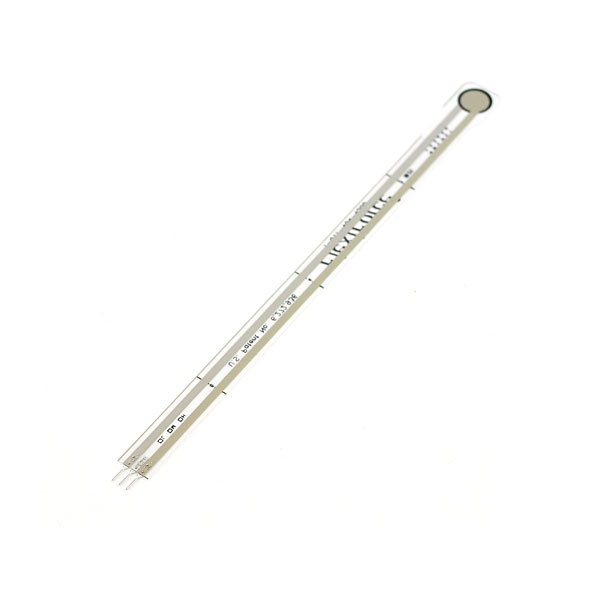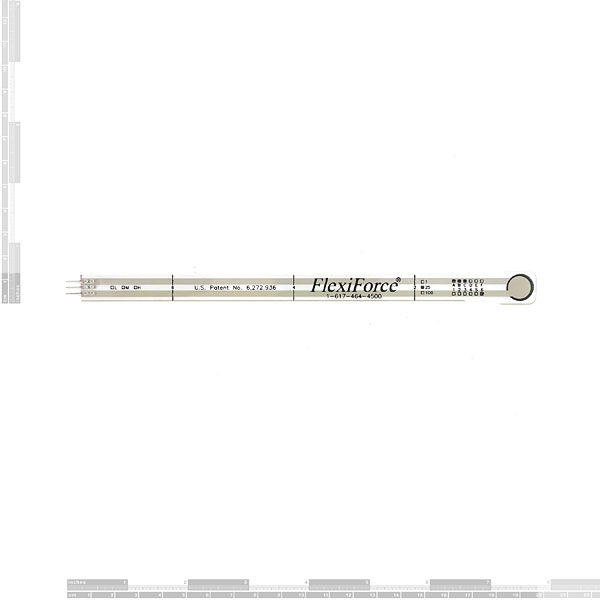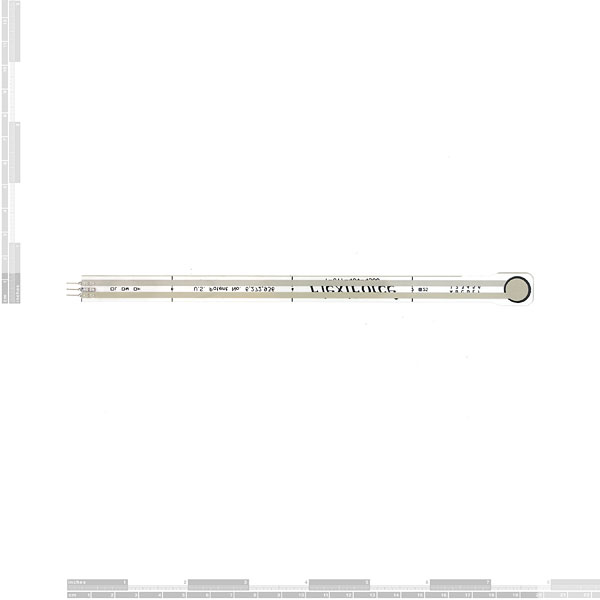FlexiForce Pressure Sensor - 100lbs.
This is a piezoresistive force sensor from Tekscan. The harder you press, the lower the sensor's resistance. Pressing hard, the resistance changes from infinite to ~300k. The sensor itself is thin and flexible, but the resistance does not change while being flexed. Resistance changes only when pressure is applied to the round area at the end of the sensor. Used as a presence sensor (someone standing), weight sensor, pressure sensor (impact testing), etc.
The overall length is about 8.5". Sensor comes with 0.1" spaced, reinforced, breadboard friendly connector.
This sensor comes in three flavors. This sensor ranges from 0 to 100lbs of pressure in the mega-ohm range.
FlexiForce Pressure Sensor - 100lbs. Product Help and Resources
Force Sensitive Resistor Hookup Guide
May 5, 2016
How to hook a force-sensitive resistor up to an Arduino to measure pressure variances.
Calibration
For information on how to calibrate your sensor go here => http://www.tekscan.com/how-do-i-calibrate-my-flexiforce-sensor.
Core Skill: Electrical Prototyping
If it requires power, you need to know how much, what all the pins do, and how to hook it up. You may need to reference datasheets, schematics, and know the ins and outs of electronics.
Skill Level: Noob - You don't need to reference a datasheet, but you will need to know basic power requirements.
See all skill levels
Comments
Looking for answers to technical questions?
We welcome your comments and suggestions below. However, if you are looking for solutions to technical questions please see our Technical Assistance page.
Customer Reviews
4 out of 5
Based on 4 ratings:
1 of 1 found this helpful:
Good sensor
It does what it's supposed to do. Quite reliable in terms of linearity, but drifts a lot with time...Very noisy in low (<3-4kg) forces. Cannot compare to load cells, but it's a good, cheap, alternative
Good depending on use. Read datasheet!
This product works well for instantaneous pressure readings BUT not for near constant weight. Drift is a big problem which needs constant adjustment. Hysteresis on decreasing weight is almost unworkable. The datasheet explains these but these errors are considerable. I emailed TEKSCAN for an equation for log time drift but received with no answer. I had to derive my own. During install, one of the four sensors was damaged. These things are very fragile. It is important to build a sturdy harness. The long flexible lead is a drawback for this product. I switched to load cells taken from a $10 bathroom scale and an HX711.
Best pressure sensor for the money
Good range with a simple set up
Works great!
Love the clean design of this product, worked perfectly for pressure sensitive floor tiles we're building.




Are these sensors sealed? Can they be used outdoors? My application would be between a rubber mat and metal baseplate, so not exposed directly to the elements, but still in an outdoor installation. Thanks!
Hi all, I have three questions. first, title says 100 lbs but datasheet says 110N and 25 lbs, which one is correct? my second question is if there is a way (mechanical or electrical hack of some sort) to measure larger forces say 250 lbs using this sensor? and my final question is if the sensor only measures the force applied to the round area, can I just cut it shot and make it a 2" sensor with the same spec?
You can measure heavier objects by putting the object on two or three legs then measure the force under one leg. It won't be very accurate, but it should give you an inexpensive ballpark estimate.
As far as cutting the sensor, I don't think it'll work the same, but it looks like you should be able to connect to it so maybe it will work.
Ignore my first question! :-p
Hey all, I made a guide on setting this up and calibrating it with an op amp and Arduino. The data is accurate, and it gives about 50 gram resolution on this sensor. Seraphdrone.com/blog/flexiforce-pressure-sensor-with-arduino
For the rest of the world: 100lb is around 45kg.
Hi, I have bought these Flexiforce sensors in order to create an insole that measure pressures points of the foot. The difficulty i am having is trying to calibrate the sensors. I have 500 g masses that I have been stacking on the the sensing area of the sensor, but I get very inconsistent voltage and resistance readings every time. Even the slightest movement to the masses creates a different reading for both voltage and resistance. Does anyone have any suggestions on how I can solve this problem?
Also, the force vs. resistance curve for the sensor shows that the resistance of the sensor drops to nearly 0 Kohms for a force above 1.3 lbs. However, I thought the sensor was still sensitive to up to 0-100 lb (according to the datasheet). Would anyone please let me know how I can detect the voltage/resistance change when different people stand on the insole if the change is resistance is not very noticeable? I will be placing the sensors on the toe, heel, first and fifth metatarsal point of the insole and need to then generate a pressure map showing the pressure points of the foot (in Matlab).
It would be great if anyone can help and thanks a lot :)
Did you manage to calibrate the sensor? I want to make also an insole and wanted to know if this sensor fits my needs.
Are you able to convert the pressure or resistance into lbs.? For example if I had 4 sensors strategically embedded into pad which was then placed on a chair seat would I be able to estimate total weight of someone sitting on that pad?
Thanks in advance!
It seems the datasheet link has died, I belive this is the new one: http://www.tekscan.com/pdf/FLX-A201-force-sensor.pdf
Hi everybody, do you know a wearable pressure sensor for 100 kg?
Is it possible to bend this material? I would like to fasten this to the end of a metal object but the tip is only about .07 inches wide so I would have to bend the other end of this. Would that still be able to sense accurately?
From the description:
Perhaps the Flex Sensor 4.5" or Flex Sensor 2.2" would be more appropriate for your use case?
Any information about linearity? What ranges perform better? [I saw the +-3%, but nothing else]
I need the HT201-H, is this it? Can you get me one?
Thanks
Does anyone know what happens if you expose this sensor to temperatures above the rated 140 degrees Fahrenheit? Does the plastic simply melt and short out?
I need to measure force in a environment that ranges between 0 and 400F. Pretty sure this component is not up to the job! Can anyone advise on an alternative?
Cheers! Dec
Google "load cell", which are available in myriad force and temperature ratings. Good luck!
They also sell a high-temperature version of this sensor on their website. http://www.tekscan.com/flexible-force-sensors . Conveniently for you, it works up to 400F
Could someone offer some advise/guidance on hooking this up straight to an arduino (sans opamp)? Per the pdf datasheet, I have the top pin going to Analog 0 (the datasheet shows this pin going to an opamp, i believe). The middle pin is nothing. The bottom pin is "Vt -1v" which I tried hooking up to 5V and 5V with a resistor. I was getting analog sensor readings in the serial monitor, but they weren't consistently correlated to pressure on the pad.
UPDATE: I figured it out. the "top pin" or left-side goes straight to 5V. The middle pin is nothing. THe right pin (or bottom pin) goes to Analog 0 (or any anolog pin you wish) but is also pulled low to ground with a resistor [I'm using a brown/black/green resistor which I believe is a 1mm ohm because it's the only one I have for the moment and it works fine). No pressure yields a zero value. It's very sensitive from 200-600. Hard pressure required to get above 600. Couldn't very easily get to 1024 (the max). code is a simple analogRead on pin0.
Is it possible to use this in a sealed container so that if i were to pump air into that it would tell be the air pressure. Or is there some other product that will do this. thanks for your time.
You could gauge both air pressure and water pressure (to answer post above) by using a pressurized bladder inside a rigid vessel and measure the pressure of the bladder against the walls of the vessel. Not very precise though.
The sensors are vented so you wouldn't be able to measure air pressure in this manner. You would need to completely cover the sensor with sealant as even the substrate is porous on a microscopic level. In any case, the sensors are intended for tactile forces, not air pressures, so you may not get the results you're looking for.
I am curious if this could be used to detect water pressure. Could I build a sealed end-pipe fitting to put the senor part inside an irrigation system to detect water pressure? Do you have a sensor more suited for that purpose?
aeroponics101
What happens if I exceed the pressure? Is it ruined?
According to the spec it can measure up to a 1000 lbs with a stronger feedback resistor, so it's rated for at least that.
How come the wire strip leading up to the sensor is so long? Is it easy to trim down or are there any other lengths available?
From the user manual: "The length of the sensors can be trimmed by Tekscan to predefined lengths of 2?, 4? and 6? or can be trimmed by the customer. If the customer trims the sensor, a new connector must be attached. This can be accomplished by purchasing staked pin connectors and a crimping tool. A conductive epoxy can also be used to adhere small wires to each conductor."